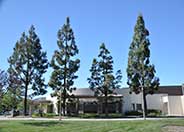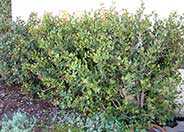
Common name:Canary Island Pine
Botanical name:Pinus canariensis
Canary Island Pine (Pinus canariensis) is a very large upright pine that is native to the Canary Islands. It can reach up to 80' tall and about 35' wide and matures to a dark green shade. This species is found throughout Southern California in parks, parking lots, and large parkways, but it is very rarely seen in residential landscapes. The natural shape and growth habit of the tree make it inherently low maintenance, as it requires almost no pruning to reach its mature height and shape. However, if it is planted in a space that is too small, it will require frequent maintenance from an arborist to manage its size. This tree should be planted at least 10 feet away from any hardscape areas, 20 feet from structures such as houses and buildings, and not near any powerlines. Shrubs and perennials should be planted about five feet away from this tree. It rarely requires any supplemental water once it is established. This tree should be irrigated for about 45 minutes once a week when using most in-line drip irrigation systems. It is not recommended for fire-prone areas. Visit the Orange County Fire Authority for more information.

Common name:Toyon
Botanical name:Heteromeles arbutifolia
Toyon is a California native evergreen shrub that grows 6'-15' high and spreading 2'-3'. It has leathery toothed leaves, white summer flowers and clusters of red winter berries. It tolerates full sun or partial shade, heat, smog, wind and heavy or light soils. It is drought tolerant, attracts beneficial insects and hummingbirds.
Maintenance Tips
Heteromeles arbutifolia is an evergreen shrub that typically grows 6-8' tall and wide. It is a very versatile plant that can also be shaped into a small tree reaching 12-15' tall if it is cultivated properly. It has a very dense branching structure and will form into a large mound of green foliage and bright red berries if left unattended. The location, space, and desired shape of this plant in your garden will determine how it should be maintained. In a naturalized garden, where it is given plenty of space to reach maturity, there so almost no maintenance involved. However, if it is located in areas with a moist climate, some thinning would be necessary for good airflow to avoid fungal diseases. If is being used as a small tree, the cross branching and lower branches should be removed as they form to encourage the desired shape of the tree. It prefers full sun, is very drought tolerant, and is unparticular about its soil conditions, so it can be grown just about anywhere.
Common name:Lemonade Berry
Botanical name:Rhus integrifolia
The Lemonade Berry is an evergreen shrub that reaches 30' high. It has aromatic leaves and develops small white to pink flowers and red berries. This shrub grows best in coastal areas and is drought tolerant. The Lemonade Berry is a native to California
Photographer: GardenSoft
Practice grass-cycling by leaving short grass clippings on lawns after mowing, so that nutrients and organic matter are returned to the soil.
Be sure to fix all leaks promptly no matter how small they may seem.
Remove irrigation water and fertilizer from areas where you don't want weeds to grow.